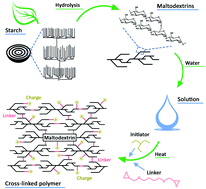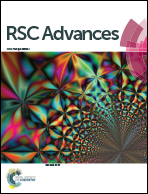One-step sustainable synthesis of cationic high-swelling polymers obtained from starch-derived maltodextrins
Abstract
The good water solubility displayed by most starch-derived maltodextrins has limited their use when specific mechanical properties are required, particularly when working in aqueous media. As a result, numerous attempts to cross-link such polysaccharides to obtain cross-linked polymers have been reported; in this context, non-toxic and biocompatible water-soluble diglycidyl ethers have performed well. Besides, amines are commonly used as curing agents in combination with diglycidyl ethers for the production of epoxy resins. For this reason, amine-mediated epoxy ring-opening reactions of 1,4-butanediol diglycidyl ether have been studied as approaches to obtain sustainable cross-linked polymers suitable for eco-friendly scaling-up, based upon commercial starch-derived maltodextrins, using water as a unique solvent.



 Please wait while we load your content...
Please wait while we load your content...